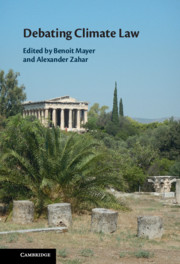Book contents
- Debating Climate Law
- Debating Climate Law
- Copyright page
- Contents
- Contributors
- Acknowledgements
- Abbreviations
- Introduction
- Debate 1: Customary Law
- Debate 2: The ILC’s Role
- Debate 3: CBDR Principle
- Debate 4: Compliance
- Debate 5: Climate Litigation
- ~ A ~ The Essential Role of Climate Litigation and the Courts in Averting Climate Crisis
- ~ B ~ Climate Litigation: A Red Herring among Climate Mitigation Tools
- Debate 6: Human Rights
- Debate 7: Historical Responsibility
- Debate 8: Climate Migration
- Debate 9: Negative-Emission Technologies
- Debate 10: Solar Radiation Management
- Debate 11: Climate Assessment
- Reflection 1: Adaptation
- Reflection 2: Loss and Damage
- Reflection 3: Disappearing States
- Reflection 4: Climate Finance
- Reflection 5: Non-State Actors
- Reflection 6: Regime Inconsistency
- Reflection 7: Aesthetics
- Conclusion
- Index
~ B ~ - Climate Litigation: A Red Herring among Climate Mitigation Tools
from Debate 5: Climate Litigation
Published online by Cambridge University Press: 15 June 2021
- Debating Climate Law
- Debating Climate Law
- Copyright page
- Contents
- Contributors
- Acknowledgements
- Abbreviations
- Introduction
- Debate 1: Customary Law
- Debate 2: The ILC’s Role
- Debate 3: CBDR Principle
- Debate 4: Compliance
- Debate 5: Climate Litigation
- ~ A ~ The Essential Role of Climate Litigation and the Courts in Averting Climate Crisis
- ~ B ~ Climate Litigation: A Red Herring among Climate Mitigation Tools
- Debate 6: Human Rights
- Debate 7: Historical Responsibility
- Debate 8: Climate Migration
- Debate 9: Negative-Emission Technologies
- Debate 10: Solar Radiation Management
- Debate 11: Climate Assessment
- Reflection 1: Adaptation
- Reflection 2: Loss and Damage
- Reflection 3: Disappearing States
- Reflection 4: Climate Finance
- Reflection 5: Non-State Actors
- Reflection 6: Regime Inconsistency
- Reflection 7: Aesthetics
- Conclusion
- Index
Summary
This chapter debates whether litigation is a meaningful way to attack the problem of climate change mitigation. For the proponents of climate litigation, who side is taken by Cinnamon Piñon Carlarne, their action has the potential to ensure that states take more ambitious action than they would have taken otherwise. But the argument developed on this side is even stronger, namely that the courts have a positive duty to take decisions in support of mitigation of emissions. Guy Dwyer, for the sceptics, contends that litigation is the least promising way to go about addressing climate change mitigation because several unavoidable hurdles that face pro-climate litigants all but guarantee their defeat. Indeed, Dwyer argues, the number of cases that might have caused emissions to be reduced can be counted on half of one hand.
Keywords
- Type
- Chapter
- Information
- Debating Climate Law , pp. 128 - 144Publisher: Cambridge University PressPrint publication year: 2021
- 2
- Cited by

